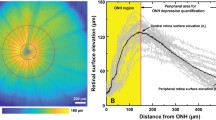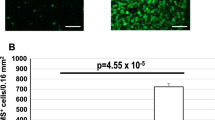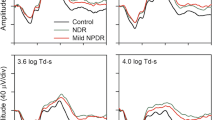Abstract
We recorded pattern electroretinograms, scotopic threshold responses, oscillatory potentials and ganzfeld flash electroretinograms in patients with glaucoma or other optic nerve diseases and in cats with inner retinal damage caused by intravitreal injections of kainic acid. In both studies, the scotopic b-wave and the scotopic threshold responses were normal but the oscillatory potentials and pattern electroretinograms were not. The photopic b-wave was also often reduced in patients with scotopic oscillatory potential reduction, and the reduction was proportionate to the oscillatory potential change. Oscillatory potentials were as frequently reduced as pattern electroretinograms in both patient groups, and in the few cases where only one response was reduced, there was no bias toward either measure. In cats, the effects of intravitreal injection of various doses of kainic acid on the retina were evaluated electrophysiologically, and structural damage was assessed histologically. After 25 nmol of kainic acid, the pattern electroretinograms and oscillatory potentials were reduced but neither the b-waves nor the scotopic threshold responses, were affected. Histologic studies of retinas after this dose showed swollen dendrites that were restricted to the outer part (off-sublamina) of the inner plexiform layer. Serial semithin sections indicated that most, if not all, of the swelling was confined to dendrites of large ganglion cells. Our results indicate that the size and sensitivity of the oscillatory potential response may have a role in the diagnosis and management of early glaucoma and optic nerve disease, and that the photopic electroretinogram may give similar information.
Similar content being viewed by others
References
Maffei L, Fiorentini A. Electroretinographic responses to alternating gratings before and after section of the optic nerve. Science 1981; 211: 953–55.
Arden GB. Vaegan, Hogg CR. Clinical and experimental evidence that the pattern electroretinogram (PERG) is generated in more proximal retinal layers than the focal ERG (FERG). Ann NY Acad Sci 1982; 580–602.
Wagner P, Pesson H. Pattern reversal electroretinograms in unilateral glaucoma. Invest Ophthalmol Vis Sci 1983; 24: 749–53.
Sieving PA, Steinberg RH. Contribution from proximal retina to intraretinal pattern-ERG: the M-wave. Invest Ophthalmol Vis Sci 1985; 26: 1642–47.
Baker CL, Hess RR, Olsen BT, Zrenner E. Current source density analysis of linear and nonlinear components of the primate electroretinogram. J Physiol (Lond) 1988; 407: 155–76.
Ogden T. The oscillatory waves of the primate electroretinogram. Vision Res 1973; 13: 1059–1074.
Heynen H, Wachtmeister L, van Norren D. Origin of the oscillatory potentials in the primate retina. Vision Res 1985; 25: 1365–373.
Sieving PA, Frishman LJ, Steinberg RH. Scotopic threshold response of proximal retina in cat. J Neurophysiol 1986; 56: 1049–61.
Sieving PA. Ganglion cell loss does not abolish the scotopic threshold response (STR) of the cat and human ERG [Abstract]. Invest Ophthalmol Vis Sci 1989; 30 (suppl.): 68.
Aylward GW. The scotopic threshold response in health and disease. [MD Thesis]. Cambridge, UK: Sancta Sophia College, 1989.
Kojima M, Zrenner E. Off-components in response to brief light flashes in the oscillatory potential of the human electroretinogram. Albrecht von Graefes Arch Klin Exp Ophthalmol 1978; 206: 107–20.
King-Smith P, Loffing DH, Jones R. Rod and cone ERGs and their oscillatory potentials. Invest Ophthalmol Vis Sci 1986; 270–73.
Peachey NS, Alexander KR, Fishman GA. Rod and cone system contributions to oscillatory potentials. An explanation of the conditioning flash effect. Vision Res 1987; 27: 859–66.
Wachtmeister L. Basic research and clinical aspects of the oscillatory potentials of the electroretinogram. Doc Ophthalmol 1987; 66: 187–94.
Wachtmeister L, el Azazi M. Oscillatory potentials of the electroretinogram in patients with unilaterial optic atrophy. Ophthalmologica 1985; 191: 39–50.
Wachtmeister L, Hahn I. Spatial properties of the oscillatory potentials of the frog electroretinogram in relation to state of adaptation. Acta Ophthalmol 1987; 65: 724–30.
Gur M, Zeevi YY, Beilik M, Neumann E. Changes in the oscillatory potentials of the electroretinogram in glaucoma. Curr Eye Res 1987; 6: 457–66.
Brodie SE, Frisch S, Siebold E, Camaras C, Lustgarten J, Serie JB, Podos S. Fourier analysis of the oscillatory potentials in glaucoma and ocular hypertension [Abstract]. Invest Ophthalmol Vis Sci 1988; 29 (suppl.): 239.
Siguenza JA, Gomez-Ramos P. Visual evoked cortical potentials in the cat after retinal modifications induced by intraocular kainic acid. Pharmacol Biochem Behav 1983; 20: 79–83.
Schwarcz R, Coyle JT. Kainic acid. Neurotoxic effects after intraocular injections. Invest Ophthalmol 1977; 16: 141–48.
Hampton CK, Garcia CH, Redburn OA. Localisation of kainic acid sensitive cells in mammalian retina. J Neurosci Res 1981; 6: 99–111.
Hughes H, Wieniawa-Narkiewiecz E. A newly identified population of presumptive microneurons in the cat retinal ganglion cell layer. Nature 1980; 284: 468–70.
Millar TJ, Morgan IG. Serotoninergic cells in the chicken retina. In: Weiler R, Osborne NN, eds. Neurobiology of the inner retina. Berlin: Springer-Verlag, 1989; H31: 445–53.
Morgan IG. Kainic acid as a tool in retinal research. In: Osborne NN, Chader GJ, eds. Progress in retinal research. Oxford, UK: Pergamon, 1984: 249–66.
Erlich D, Morgan IG. Kainic acid destroys displaced amacrine cells in the posthatch chick retina. Neurosci Lett 1980; 17: 43–48.
Dvorak DR, Morgan IG. Intravitreal kainic acid permanently eliminates off-pathways from chick retina. Neurosci Lett 1983; 36: 249–53.
Ingham CA, Morgan IG. Dose dependent effects of intravitreal kainic acid on specific cell types in chicken retina. Neuroscience 1983; 9: 165–81.
De Nardis R, Sattayasai J, Zappia J, Ehrlich D. Neurotoxic effects of kainic acid on developing chick retina. Dev Neurosci 1988; 10: 256–69.
Vaegan, Millar TJ, Arora A. The effect of kainic acid on the pattern electroretinogram of the urethane anaesthetised cat. Neurosci Lett 1989; 34: S161.
Arora A, Vaegan, Millar TJ. The effect of kainic acid (KA) and N-methyl-aspartate (NMDA) on the electroretinogram (ERG) and morphology of the cat retina. Neurosci Lett 1989; 34: S54.
Vaegan, Millar TJ. High sensitivity of the oscillatory potentials (OPs) of the electroretinogram (ERG) to excitatory amino acid (EAA) toxicity in cats and to optic atrophy in man [Abstract]. Invest Ophthalmol Vis Sci 1990; 30 (suppl.): 392.
Vaegan, Graham SL, Millar TJ. Oscillatory potential (OP) and pattern electroretinogram (PERG) reduction with normal electroretinograms after retinal ganglion cell damage by disease in man and by kainic acid toxicity in cat. Presented at the 28th ISCEV Symposium, Guangzhou, China, March 1990.
Arden GB, Carter RM, Hogg CR, Powell DJ, Ernst W, Clover GM, Lyness AL, Quinlan MP. A modified ERG technique and the results obtained in X-linked retinitis pigmentosa. Br J Ophthalmol 1983; 67: 419–30.
Weinstein GW, Arden GB, Hitchings RA, Ryan S, Calthorpe CM, Odom JV. The pattern electroretinogram (PERG) in ocular hypertension and glaucoma. Arch Ophthalmol 1988; 106: 923–28.
Vaegan. An improved method of constructing pattern electroretinogram electrodes. Doc Ophthalmol Proc Ser 1984: 40: 287–93.
Brindley GS, Westheimer G. Spatial properties of the human electroretinogram. J Physiol (Lond) 1965; 179: 518–37.
Millar TJ, Vaegan, Arora A. Urethane as a sole anaesthetic for vision research in cats. Neurosci Lett 1989; 103: 108–12.
Ogden T. Clinical electrophysiology. In: Ogden TE, Schacht AP, eds. Retina, Vol. 1. St. Louis: CV Mosby, 1989: 285–96.
Lachapelle P. Analysis of the photopic electroretinogram recorded before and after dark adaptation. Can J Ophthalmol 1987; 22: 354–61.
Miyake Y, Shiroyama N, Horiguchi M, Ota I. Asymmetry of focal ERG in human macular region. Invest Ophthalmol Vis Sci 1989; 30: 1743–49.
Rothman SM. The neurotoxicity of excitatory amino acids is produced by passive chloride influx. J Neurosci 1984; 5: 1483–89.
Choi DW. Glutamate neurotoxicity in cortical cell culture is culture is calcium dependent. Neurosci Lett 1985; 58: 293–97.
Author information
Authors and Affiliations
Rights and permissions
About this article
Cite this article
Vaegan, Graham, S.L., Goldberg, I. et al. Selective reduction of oscillatory potentials and pattern electroretinograms after retinal ganglion cell damage by disease in humans or by kainic acid toxicity in cats. Doc Ophthalmol 77, 237–253 (1991). https://doi.org/10.1007/BF00161371
Issue Date:
DOI: https://doi.org/10.1007/BF00161371




